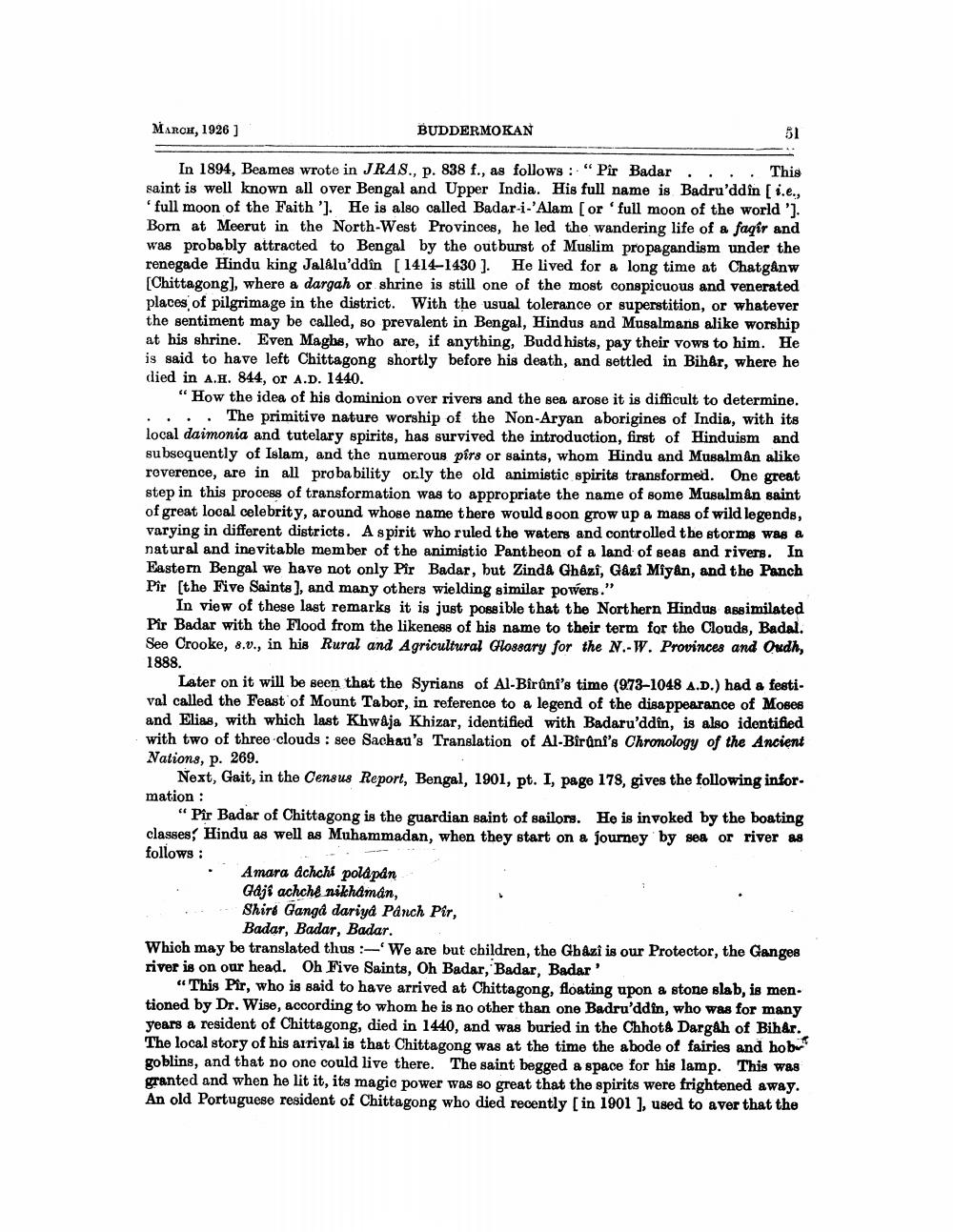________________
MARCH, 1926 ]
BUDDERMOKAN
In 1894, Beames wrote in JRAS., p. 838 f., as follows: "Pir Badar.... This saint is well known all over Bengal and Upper India. His full name is Badru'ddin [i.e., 'full moon of the Faith '). He is also called Badar-i-'Alam (or 'full moon of the world '). Born at Meerut in the North-West Provinces, he led the wandering life of a faqir and was probably attracted to Bengal by the outburst of Muslim propagandism under the renegade Hindu king Jalalu'ddîn [1414-1430). He lived for a long time at Chatgânw
Chittagong], where a dargah or shrine is still one of the most conspicuous and venerated places of pilgrimage in the district. With the usual tolerance or superstition, or whatever the sentiment may be called, so prevalent in Bengal, Hindus and Musalmans alike worship at his shrine. Even Maghs, who are, if anything, Buddhists, pay their vows to him. He is said to have left Chittagong shortly before his death, and settled in Bih&r, where he died in A.H. 844, or A.D. 1440.
"How the idea of his dominion over rivers and the sea arose it is difficult to determine. ... The primitive nature worship of the Non-Aryan aborigines of India, with its local daimonia and tutelary spirits, has survived the introduction, first of Hinduism and subsequently of Islam, and the numerous pírs or saints, whom Hindu and Musalman alike roverence, are in all probability orly the old animistic spirits transformed. One great step in this process of transformation was to appropriate the name of some Musalman saint of great local celebrity, around whose name there would soon grow up a mass of wild legends, varying in different districts. A spirit who ruled the waters and controlled the storms was a natural and inevitable member of the animistic Pantheon of a land of seas and rivers. In Eastern Bengal we have not only Pir Badar, but Zinda Ghazi, Gazi Miyan, and the Panch Pir (the Five Saints), and many others wielding similar powers."
In view of these last remarks it is just possible that the Northern Hindus assimilated Pir Badar with the Flood from the likeness of his name to their term for the Clouds, Badal. See Crooke, 8.v., in his Rural and Agricultural Glossary for the N.-W. Provinces and Oudh, 1888.
Later on it will be seen that the Syrians of Al-Biruni's time (973–1048 A.D.) had a festi. val called the Feast of Mount Tabor, in reference to a legend of the disappearance of Moses and Elias, with which last Khwaja Khizar, identified with Badaru'ddin, is also identified with two of three clouds : see Sachau's Translation of Al-Birani's Chronology of the Ancient Nations, p. 269.
Next, Gait, in the Census Report, Bengal, 1901, pt. I, page 178, gives the following infor. mation:
"Pir Badar of Chittagong is the guardian saint of sailors. He is invoked by the boating classes, Hindu as well as Muhammadan, when they start on a journey by sea or river as follows:
Amara achchi pola pan Gaji achche nikhaman, Shird Ganga dariya Panch Pir,
Badar, Badar, Badar. Which may be translated thus 'We are but children, the Gházi is our Protector, the Ganges river is on our head. Oh Five Saints, Oh Badar, Badar, Badar
“This Pir, who is said to have arrived at Chittagong, floating upon a stone slab, is mentioned by Dr. Wise, according to whom he is no other than one Badru'ddin, who was for many years a resident of Chittagong, died in 1440, and was buried in the Chhota Dargah of Bihar. The local story of his arrival is that Chittagong was at the time the abode of fairies and hobv goblins, and that no one could live there. The saint begged a space for his lamp. This was granted and when he lit it, its magic power was so great that the spirits were frightened away. An old Portuguese resident of Chittagong who died recently [in 1901 ], used to aver that the




